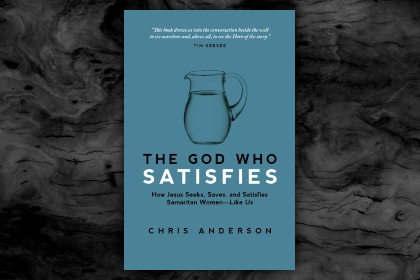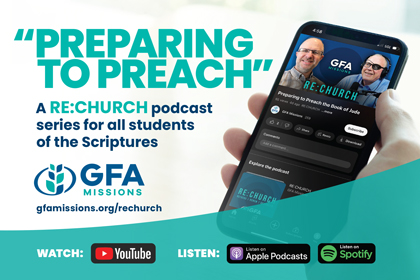Killing the lecture! A better way for preaching?
Image

Abraham Kuruvilla’s A Vision for Preaching is a wonderful, refreshing book. The work is an exposition of one statement:1
Biblical preaching, by a leader of the church, in a gathering of Christians for worship, is the communication of the thrust of a pericope of Scripture discerned by theological exegesis, and of its application to that specific body of believers, that they may be conformed to the image of Christ, for the glory of God—all in the power of the Holy Spirit.
I will focus on two aspects; (1) the thrust of the passage,2 and (2) how to apply scripture.
The sermon—bullet or buckshot?
Like many pastors, I read Haddon Robinson’s book Biblical Preaching at seminary. In that classic tome, Robinson explained his “big idea” approach to preaching:3
A major affirmation of our definition of expository preaching, therefore, maintains that ‘expository preaching is the communication of a biblical concept.’ That affirms the obvious. A sermon should be a bullet, not buckshot. Ideally each sermon is the explanation, interpretation, or application of a single dominant idea supported by other ideas, all drawn from one passage or several passages of Scripture.
Kuruvilla is against this approach. The sermon, he argues, is not an argument in service to a particular “point” in the text. That is the “old” homiletic,4 where “the point” drives the structure of the sermon:5
Craddock’s wry observation (noted earlier) in this regard is worth repeating: ‘The minister boils off all the water and then preaches the stain in the bottom of the cup.’ Thereby, sermons turn out to be ‘didactic devices,’ more about arguments to persuade listeners to buy into these propositions, and less about texts and what they (or their authors) are doing. All this may even imply that once one has gotten the distillate of the text, that is, the reduction of the text into one or more propositions, one can abandon the text itself.
This, Kuruvilla insists, is not the way. Instead, the sermon is about what the author is doing with the passage. The preacher is a tour guide, a docent,6 and his role is to point out what the biblical author is doing with the text—not to re-package it into a “point” or “big idea” to be argued to the congregation.7 The text is not a plain glass window the preacher points through towards some “big idea” beyond. Rather, it is a stained-glass window the reader must look at.8
So, Kuruvilla argues, the author is doing something with the text. There is a layer behind the onion of the simple words. For example, pretend my wife says, “the trash is full!” She is indeed telling me the trash is full, but she really wants to move me to action—she wants me to take the trash out!9 So, Kuruvilla’s point is there is no “big idea” or “big argument” or “series of points.” There is only the preacher as tour guide, showing what the author is doing, in his context.
Application
This means, for Kuruvilla, application is always based on the theology of the passage.10 “Specifically, the ‘theology’ in the “theological hermeneutic” proposed here is pericopal theology, not biblical or systematic theology.”11 Each text has a message for God’s people. It might be more than one “big idea.” Whatever the passage communicates, whatever the author is doing with his message, that is the basis for application.12
Ironically, Kuruvilla manages his best explanation of his view (his “Big Idea,” perhaps!) in an academic article, not in this book:13
What is needed in the pulpit, then, is a creative exegesis of the text undertaken with a view to portraying for listeners what the author is doing—pericopal theology—enabling their experience of the text + theology.
The sermon is not a lecture; “my three points this morning are on the screen!” The sermon is where the pastor pulls back the curtain and show what he found behind it in his own study.14 This is the great challenge—to structure sermons in an engaging, inductive way to let the congregation “see” the theology of the passage.
Kuruvilla’s book is a tour de force. It is a breath of fresh air from the redemptive-historical and other biblical theology approaches that seek to impose a framework for application into each text. Bryan Chapell recommends we use “gospel glasses” to see redemption in every text.15 This is incorrect—some passages just are not about redemption, and to make them so will rip them out of context.
1 Abraham Kuruvilla, A Vision for Preaching: Understanding the Heart of Pastoral Ministry (Grand Rapids: Baker, 2015), p. 7.
2 I will routinely use the phrase “passage,” whereas Kuruvilla prefers “pericope.” His definition is more expansive than normal. “Though the term is usually applied to portions of the Gospels, I use it in this work to indicate a slice of text in any genre that is utilized in Christian worship for preaching. In other words, a ‘pericope’ is simply a preaching text, regardless of genre or even size. It is through pericopes, read and exposited in congregations as the basic units of Scripture, that God’s people corporately encounter God’s word,” (Ibid, p. 116).
3 Haddon Robinson, Biblical Preaching, 2nd ed. (Grand Rapids: Baker, 2001), p. 35.
4 “The modus operandi of the ‘old’ homiletic is to put the text through a grinder and then preach, in points, the pulverized propositional products that come out of the contraption,” (Kuruvilla, Vision, pp. 95-96).
5 Ibid, p. 99.
6 “… we must reconceive the role of preachers. I propose the analogy of a curator or docent guiding visitors in an art museum through a series of paintings Each text is a picture, the preacher is the curator, and the sermon is a curating of the text-picture and its thrust for the congregants, gallery visitors. A sermon is thus more a demonstration of the thrust of the text than an argument validating a proposition. A creative exegesis of the text is undertaken in the pulpit with a view to portraying for listeners what the author is doing. The sermon unveils the author’s agenda. The distillation of the text into points and propositions is thereby obviated. Instead, as Long describes, the preacher is a “witness” of the text, to the text—equivalent to my analogy of the preacher being a curator of the text-picture,” (Ibid, pp. 103-104).
7 “Thus, for the longest time, preaching has been conducted as a forensic argument that proves the putative proposition of the text for the congregation—an act of reasoning, a parceling of information, and an appeal to the cognitive faculties of listeners to bring them to a rational conviction about that proposition,” (Ibid, pp. 100-101).
8 Abraham Kuruvilla, “Time to Kill the Big Idea?” in JETS 61.4 (2018), 831.
9 This is actually Kuruvilla’s own hypothetical example from his conversation with Hershael York on York’s Pastor Well podcast. “Episode 36: Abraham Kuruvilla discusses hermeneutics and the gift of singleness,” (19 August 2019). Retrieved from https://equip.sbts.edu/podcast/episode-36-abraham-kuruvilla-discusses-hermeneutics-gift-singleness/.
10 “What the pericope affirms in its theology forms the basis of the subsequent move to derive application,” (Kuruvilla, Vision, p. 121).
11 Ibid.
12 Ibid, p. 122.
13 Kuruvilla, “Big Idea,” 842.
14 Ibid, 843.
15 “A preacher who asks the following basic questions takes no inappropriate liberties with a text: What does this text reflect of God’s nature that provides redemption? What does this text reflect of human nature that requires redemption?” (Bryan Chapell, “Redemptive-Historic View,” in Homiletics and Hermeneutics, ed. Scott Gibson and Matthew Kim [Grand Rapids: Baker, 2018], p. 16).
Tyler Robbins 2016 v2
Tyler Robbins is a bi-vocational pastor at Sleater Kinney Road Baptist Church, in Olympia WA. He also works in State government. He blogs as the Eccentric Fundamentalist.
- 153 views
Tyler, thanks for this. If you would allow me, I have a few observations:
- “In that classic tone” — should read “in that classic tome”
- Based on how you describe Kuruvilla’s thesis, I would tend to agree, if another way of stating the thesis is, “the passage should shape the message.” In other words, every sermon shouldn’t be a one-point wonder. Rather, the contour of the message should reflect the contour of the passage.
- Allowing the passage to shape the message does allow your congregation to see what the author is doing. It helps the audience understand the author’s main idea(s) and shows how the author supports them. Really, your sermon should always be teaching your congregation how to read / interpret their Bibles. That is why sermons that aren’t expositional in nature are not only bad but also harmful to your people.
- I’m not sure how “killing the lecture” accurately reflects Kuruvilla’s thesis. Kuruvilla is still using one-way discourse to communicate to his audience. Does the use of powerpoint really change that? Not really.
I fixed the typo, and one other mistake I saw! I wrote this review in the context of a doctoral class, so I had a word limit. I really like Kuruvilla. I bought two more of his books, but won’t have time to work through them until mid-January. Judging from other comments you’ve made on other threads, you would likely appreciate Kuruvilla’s recent criticisms of the “big idea” approach to preaching. See some of that here.
For a defense of the title, see footnotes 4-7. Kuruvilla is against the sermon as a dry exercise in driving a series of “points ” The sermon, he argues, isn’t an argument to prove a point at all. But, via the Roman numeral and points in so many outlines, we can turn the sermon into almost a legal argument. Something like, “Peter’s main point is ***. There are three reasons for this. The first reason is **** (sermon begins) …”
Tyler is a pastor in Olympia, WA and works in State government.
I’ll take a closer look at Kuruvilla.
In preaching a sermon, especially an epistle, it’s always helpful to trace the argument of the author. It sounds like Kuruvilla would agree.
Tyler, I’ve followed Kuruvilla with great interest since I was introduced to his material a few years back. I’ve read each of his three preaching texts. He has a web-site (homiletix.com) with journal articles, book reviews, videos of sermons and interviews. All of his preaching books are good and, when read in order, they build his case. Those who hold to literal interpretation of scripture (as opposed to looking for Christ in every passage), with an emphasis on application in preaching (rather than simply re-stating the gospel week after week) will find a welcome oasis of material with Kuruvilla. And you’ll be challenged to improve your preaching.
Great. I’ve read this one by him, and must read two others. I appreciate what he says, and it is wonderful to have to dig back into homiletical and hermeneutical issues after many years. I hadn’t read anything on this since seminary, but have been reading quite a bit for an upcoming doctoral class. Great fun. Very thought-provoking.
Tyler is a pastor in Olympia, WA and works in State government.
What Kuruvilla seems to recommend is a look through the Scripture in the way a good English professor would take you through great literature, or an art critic or historian would walk you through great works of art. “Now look here…..what is the author/artist doing…..?”
In light of what I see far too often—the preacher using the text as a starting point from whence to say what he really wanted to talk about—I applaud this, wholeheartedly.
Aspiring to be a stick in the mud.
Anytime you get your people to look at and study the text of Scripture for what is actually there instead of relying upon your witty and creative sermon presentation is a win.
Came across this gem in Kuruvilla’s other book, A Manual for Preaching, and I thought I’d share:
… we preachers are consumed with what is best labeled a “hermeneutic of excavation” and have been trained to shovel up loads of dirt, boulders, potsherds, arrowheads, and fishhooks. We dump it all on our desks. Everything in the text, it seems, is equally important and crucial, and there is hardly any discriminating inference or integration that leads to an understanding of what the author is doing—the theology of the pericope. Like cows at pasture, we munch on every available blade of grass, and commentaries abundantly furnish those pieces of herbage for our consumption.
The overestimation of the values of all these bits and bytes of information that we have unearthed (or that are served to us by commentators) oft leads the interpretive enterprise astray. And so, on Saturday night we ask in desperation, “What on earth do we do with this mass of material come Sunday morning? What’s the author doing here? What’s important and what’s not? And how do we create a sermon and get to valid application?”
Kuruvilla, Abraham. A Manual for Preaching (p. 7). Baker Publishing Group. Kindle Edition.
At my regional fellowship conference a few months ago, the speaker for three days was what is best described as a MacArthur man. He’s a Masters man - indeed, he’d spent 25 years on staff at Grace Community Church. He preached just like JMac. What we received for three days was essentially an audiobook commentary. I even learned a few Latin words. It wasn’t preaching.
Tyler is a pastor in Olympia, WA and works in State government.
This relates to Kuruvilla’s concept of seeing the scriptures as a stained glass that needs to be viewed rather than a clear glass through which we need to peer to see what is behind it. In other words, preach the text, not the backgrounds. After all, it is the text that is inspired, not the backgrounds behind the text.
I really like Kuruvilla. A lot. The more I think on it, on the idea of a preacher being a docent who shows the congregation that stained glass window (rather than the object lying beyond the window), on the idea of discovering what the author is doing with what he’s saying, the more I think he’s right.
I corresponded with Kuruvilla a few weeks ago, and this is what I wrote:
Over the past two years or so, I’ve begun moving away from “big idea” preaching in a subtle way. I didn’t have a comprehensive explanation for why, but the “big idea” approach felt too forced. It seemed as though I was flattening everything to make it all fit. As I preached through the Gospel of Mark, it became impossible to focus on one single idea and exclude so much else going on in the passage.
Instead of making the sermon about me proving and showing the big idea, I began to make it more of an exploration of the author’s intent … with me being the tour guide. As I preached, I’d ask rhetorical questions aloud that I myself asked as I prepared the sermon, and we’d “discover” Mark’s message in that passage together. I couldn’t put my finger on what I was doing, but it seemed much more natural.
Now, I read your book for a DMin class, and it somehow encapsulates exactly what I’ve been reaching for in the dark. It’s precisely what I’ve doing, but now I have a framework that explains what I hadn’t yet fully formed in my own mind.
Tyler is a pastor in Olympia, WA and works in State government.
I find both types of preaching to be useful. Yes, MacArthur preaches. Maybe you don’t like that style, but you aren’t the sole arbiter of what “preaching” is. Nor is Kuruvilla.
That being said, I like Kuruvilla’s arguments as well.
My conclusion is both types of preaching are needed. If you want to cruise through Genesis pericope by pericope (and K’s first pericope in Genesis is Gen 1:1-2:3) then do it. You might want to slow down and do verse by verse, or parts of verses in a sermon. The situation and need dictates what is appropriate.
Mark wrote:
but you aren’t the sole arbiter of what “preaching” is. Nor is Kuruvilla.
I realize that. Still, we can have a discussion. I don’t think the “audiobook commentary” approach is proper preaching at all. I also don’t think you do justice to the text as text by atomizing it into bite-size chunks. For example, if you take Zechariah’s song (Lk 1:67-79) and break into into, say, four sermons then you’re making a mistake. It’s one unit, one passage, one composition. It shouldn’t be atomized and used as foundations for other things (e.g. a sermon from Lk 1:67-70 about God’s promises through the prophets).
Once you touch homiletics, you get strong reactions. I know many people would disagree, and the “audiobook commentary” school has its proponents, and many people like it. I understand. I just don’t think it’s the right way to treat the text. If that’s what you want, why can’t you just put your mobile phone in the pulpit, bring up Audible, select a commentary, and press “play?” Sidney Greidanus suggested much the same (albeit in 1970) when he wrote against the dangers of sermons as lectures.
Tyler is a pastor in Olympia, WA and works in State government.
Yes, there is considerable disagreement, even amongst those who advocate expositional preaching, on what constitutes a good sermon. I know a pastor who believes every point of the sermon should be an application of the text. So, your outline should not describe the text / point of the author but how you want your people to respond to the text / point of the author.
I understand what he’s trying to do with this, but it seems artificial. Every week his sermon outlines are just a list of things to do. Yes, it’s important to communicate the application and significance of the passage to your people, but you must first communicate what the passage means and show how the author communicates that meaning before you jump to application.
At the risk of inviting lots of criticism, here is an example. I preached one sermon from Luke 1:39-56. I believed the author is showing us God encouraging Mary in a time of extraordinary doubt and confusion after Gabriel visited her. I think Elizabeth’s conversation and Mary’s song each stem from God’s encouragement to Mary. So, I didn’t break this into several sermons or pause to flesh out the theological implications of everything Mary said. I cast the entire thing as a response to encouragement, and Mary’s joy as she was encouraged. That was what I believed Luke was doing with what he was saying.
I know many other preachers would have preached several sermons, or dwelt on the theological implications of the incarnation. I understand. I don’t think that was the point of the passage, as if Mary were coldly analyzing the theological significance of it all dispassionately. My sermon and the notes are here.
I was much closer to Kuruvilla here than I was to the audiobook commentary school. I used to be a part of the audiobook school. But, I don’t think it’s the best way.
Tyler is a pastor in Olympia, WA and works in State government.
Thoward’s comment about some thinking that “every point of the sermon ought to be an application of the text” got me to thinking, and perhaps we simply need to remember that what Kuruvilla endorses is just one “baby step” where the pastor can choose to read the Word as the original readers might have instead of reading in our own prejudices and culture.
As such, it can be extremely powerful to inoculate us against the habits of hasty generalization (e.g. “prooftexting” arguments), but like all exegesis, it needs to be subjected to a look at the larger context before we really get going on applications.
On the flip side, we might argue that an accurate picture of the ministry of Christ, the Prophets, the Apostles, and the early church is itself the application. On an evangelistic tone, the listener might decide “I want to get to know this Christ”, and on a place of sanctification, one might decide “I want to act more like this person in the text.” Would we perhaps wonder if at times, our applications are more specific than the text warrants, and maybe we ought to take a step back and, in the words of professors, “leave the application as an exercise for the hearer”?
Aspiring to be a stick in the mud.







Discussion